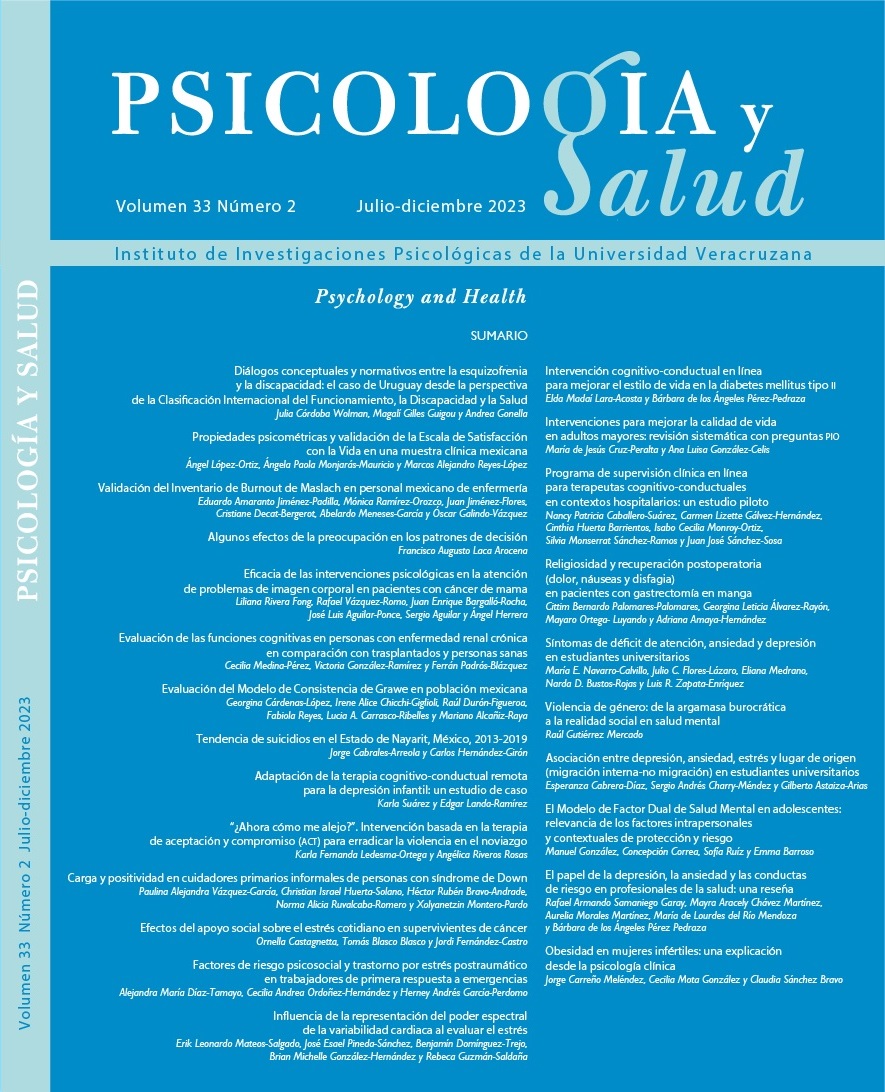Abstract
Objective. Analytically describe the effect depression, anxiety, and risk behaviors have on the health team. In these psychosocial factors, recognizing that health personnel suffers from depression is vital to excellent or inadequate health care for the general population; if it is not detected, it cannot be treated. The condition must not evolve since it can be associated with attempts or suicide; it is common in inmates, residents, and attending physicians due to the stress they experience. Anxiety is frequent because there is a responsibility to preserve life in the health team, then frustration, suffering, helplessness, fear, apprehension, and worry arise. Regarding risk behaviors, high exposure to risk factors such as alcohol consumption, tobacco, and a sedentary lifestyle dramatically affects general health and life expectancy for many years in health personnel. We consider it necessary to carry out more systematic studies on psychosocial factors in health professionals, where it is imperative to have a broader vision of the mental health situation that they are going through and that allows the implementation of strategies that strengthen working conditions, preventive medicine, in addition to improving and guaranteeing a better quality of care for patients.
References
American Psychiatric Association (2014). Manual Diagnóstico y Estadístico de los Trastornos Mentales (5ª ed.). México: Editorial Médica Panamericana.
Ansorena, Á., Cobo, J. y Romero, I. (1983). El constructo de ansiedad en psicología. Estudios de Psicología, 16, 31-45.
Bazán R., G.E., Osorio G., M., Torres V., L.E., Rodríguez M., J.I. y Ocampo J., J.A. (2019). Validación de una escala sobre estilo de vida para adolescentes mexicanos. Revista Mexicana de Pediatría, 86(3), 112-118.
Catell, R.B. y Scheier, I.H. (1961). The meaning and measurement of neuroticism and anxiety. New York: Ronald Press.
Corona, F. y Peralta, E. (2011). Prevención de conductas de riesgo. Revista Médica Clínica Las Condes, 22(1), 68-75.
Endler, N.S. y Kocovski, N.L. (2001). State and trait anxiety revisited. Anxiety Disorders, 15, 231-245.
Feeney, S., O’Brien, K., O’Keeffe, N., Iomaire, A.N., Kelly, M.E., McCormack, J., McGuire, G. y Evans, D.S. (2016). Practique lo que predica: comportamientos de salud y estrés entre los médicos del hospital que no son consultores. Medicina Clínica, 16(1), 12-18.
Fernández A., E., García, B., Jiménez, M., Martín, M. y Domínguez, F. (2010). Psicología de la emoción. Madrid: Editorial Universitaria Ramón Areces.
Goldberg, D. y Huxley, P. (1992). Common mental disorders. A bio-social model. London: Tavistock/Routledge.
Gómez M., S., Ballester A., R., Gil J., B. y Abizanda C., R. (2015). Ansiedad, depresión y malestar emocional en los profesionales sanitarios de las Unidades de Cuidados Intensivos. Anales de Psicología, 31(2), 743-750.
Jessor, R. (1991). Risk behavior in adolescence: A psychosocial framework understanding and action. Journal of Adolescence Health, 12, 597-605.
Krauskopf, D. (2002). Las conductas de riesgo en la fase juvenil. Recuperado de http://www.iin.oea.org/Cursos_a_distancia/Lecturas%208y9_UT_1.pdf.
Martínez, L., Medina-Mora, M.E. y Rivera, E. (2005). Adicciones, depresión y stress en médicos residentes. Revista de la Facultad de Medicina de la UNAM, 48(5),191-197.
McReynolds, P. (1975). Historical antecedents of personality assessment. En P. McReynolds (Ed.): Advances in psychological assessment (v. 3, pp. 477-532). San Francisco, CA: Jossey-Bass.
Medina-Mora, M.E., Fleiz B., C. y Zambrano R., J. (2004). La depresión con inicio temprano: prevalencia, curso natural y latencia para buscar tratamiento. Salud Pública de México, 46(5), 417-424.
Organización Panamericana de la Salud (2018). La carga de los trastornos mentales en la región de las Américas. Washington, D.C.: OPS.
Páramo M., A. (2011). Factores de riesgo y factores de protección en la adolescencia: análisis de contenido a través de grupos de discusión. Terapia Psicológica, 29(1), 85-95.
Pita, S., Vila, M.T. y Carpente, J. (2002). Determinación de factores de riesgo. Atención Primaria en la Red, 197(4), 75-78.
Rotenstein, L., Ramos, M., Torre, M., Segal, B., Peluso, M., Guille, C., Sen, S. y Mata, D. (2016). Prevalence of depression, depressive symptoms, and suicidal ideation among medical students: A systematic review and meta-analysis. Journal of the American Medical Association, 316(21), 2214-2236.
Sarudiansky, M. (2013). Ansiedad, angustia y neurosis. Antecedentes conceptuales e históricos. Psicología Iberoamericana, 21(2), 19-28. Recuperado de http://www.redalyc.org/articulo.oa?id=133930525003.
Spielberger, C.D. (1972). Anxiety as an emotional state. En C.D. Spielberger (Ed.): Anxiety behavior (pp. 23-49). New York: Academic Press.
Sudupe, J., Taboada, O. y Castro, C. (2006). Depresión. Guías Clínicas, 6(11), 1-6.
Ulriksen V., M. (2003). Presentación. En D. Le Breton (Comp.): Adolescencia bajo riesgo (pp. 9-14). Montevideo: Ediciones Trilce.
Ulriksen V., M. (2009). Mundos adolescentes y vértigo civilizatorio. Montevideo: Ediciones Trilce.
Watson, J.B. y Rayner, R. (1920). Conditioned emotional reactions. Journal of Experimental Psychology, 3(1), 1-14.
Zarragoitía A., I. (2011). Depresión. Generalidades y particularidades. La Habana: Ciencias Médicas.

